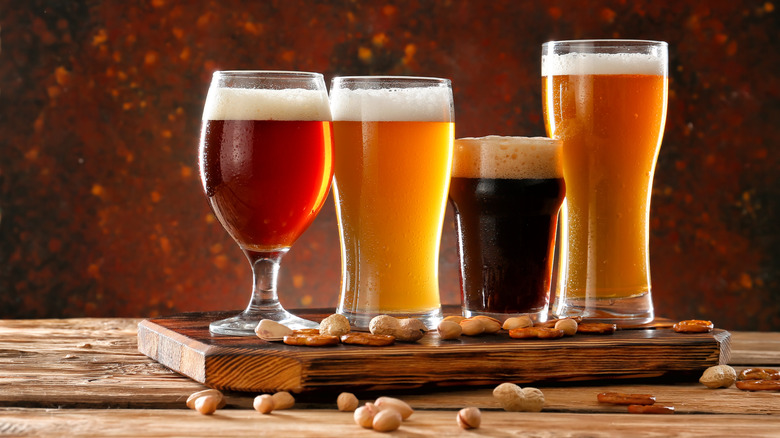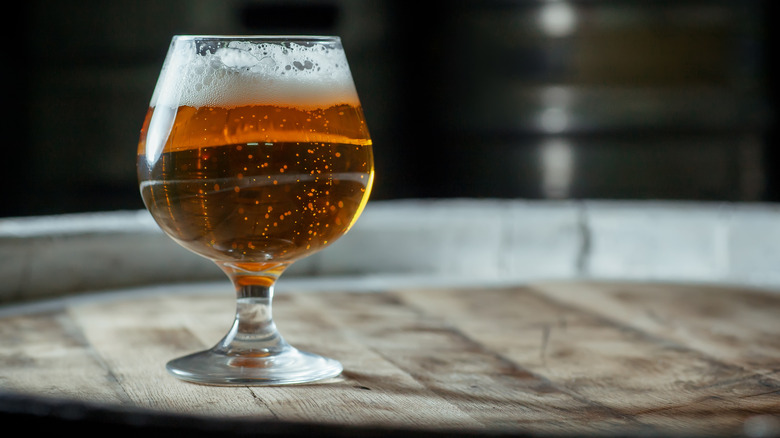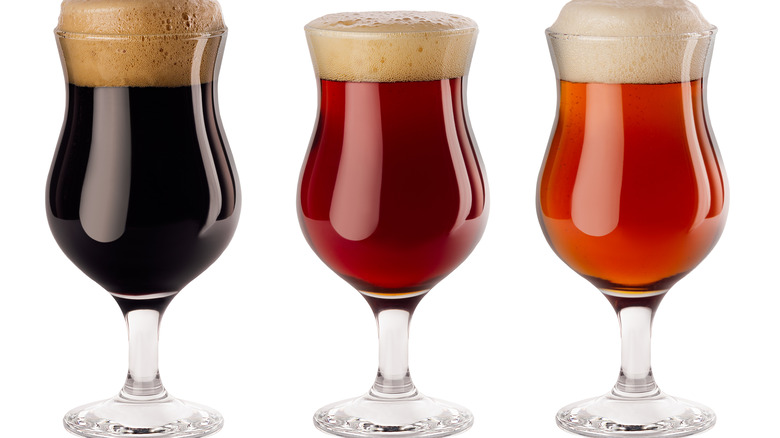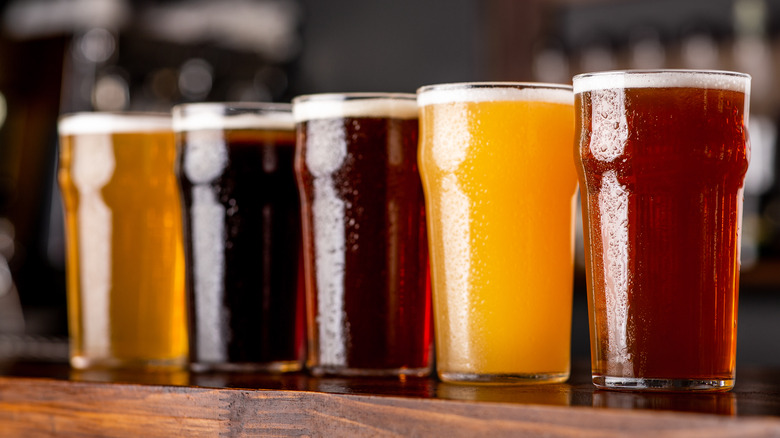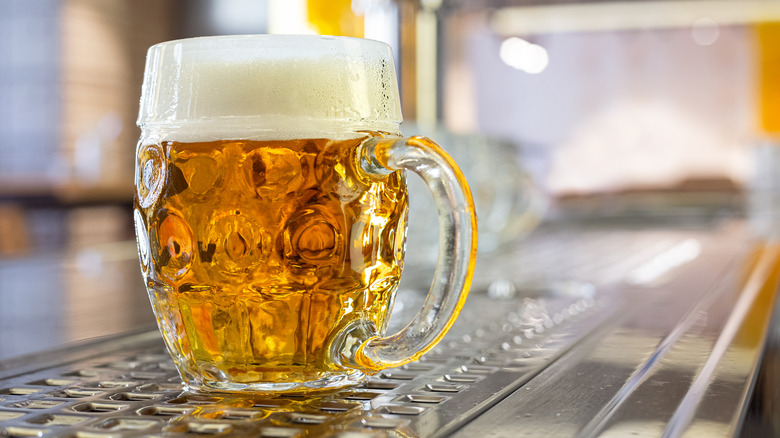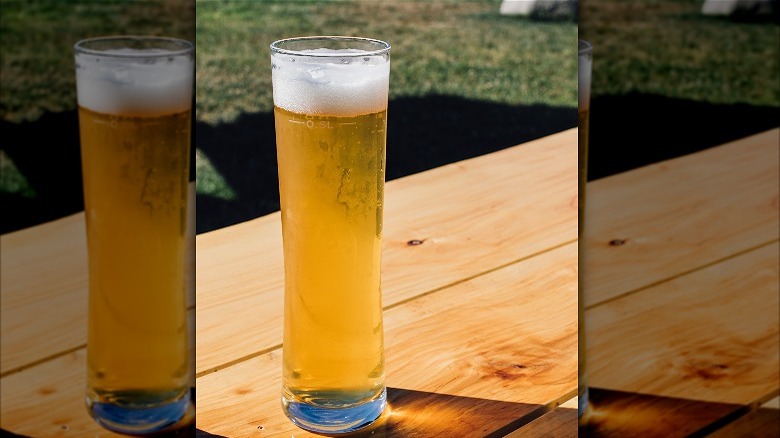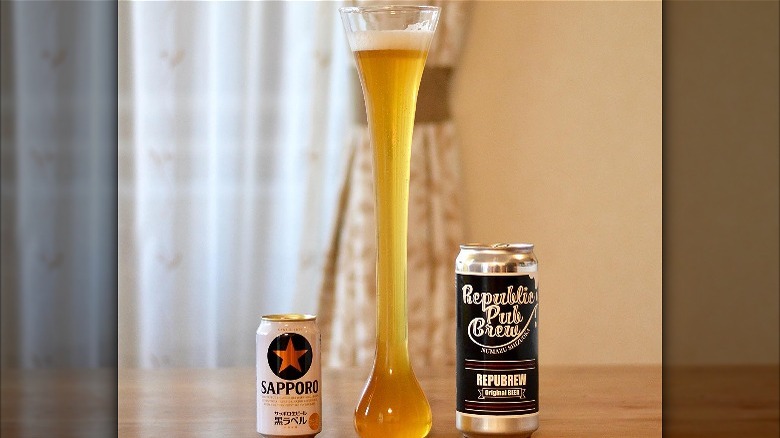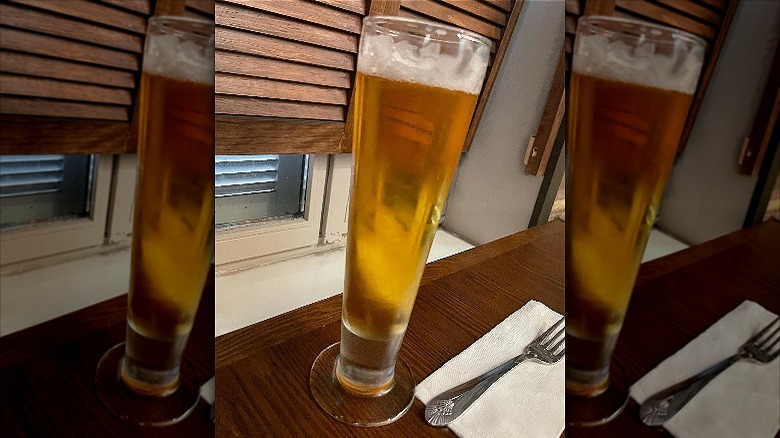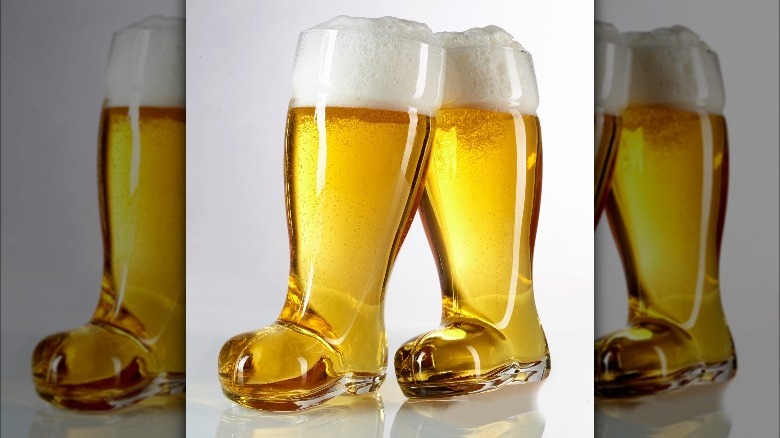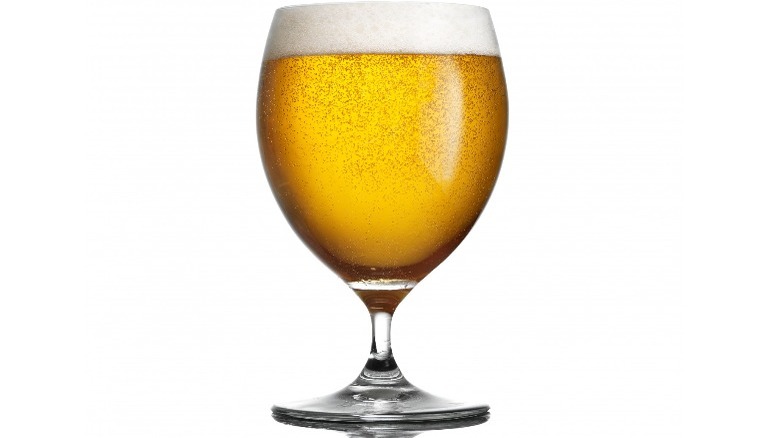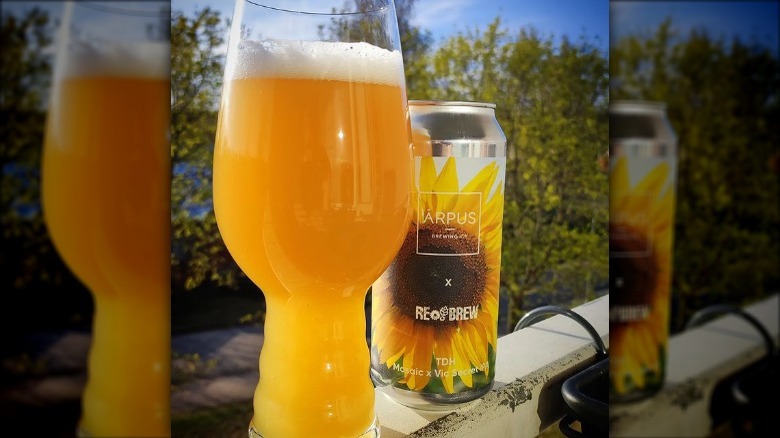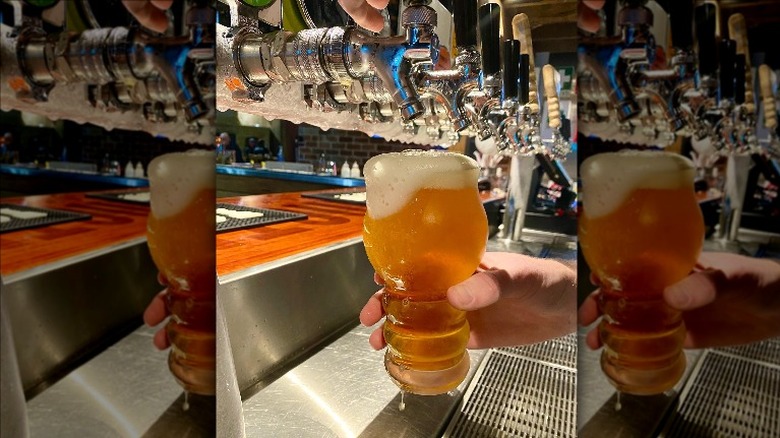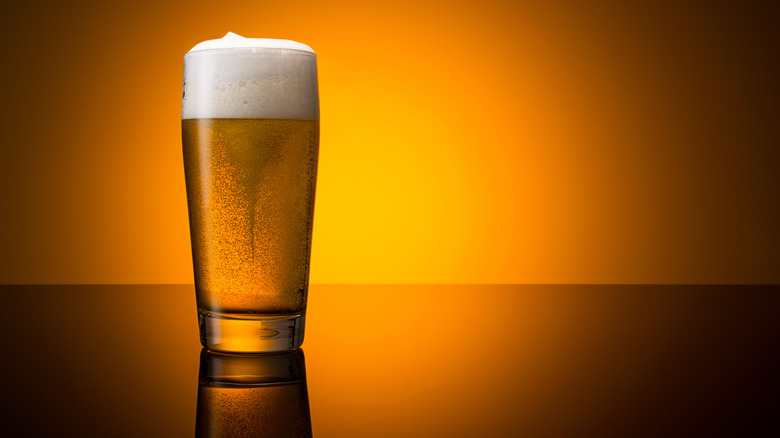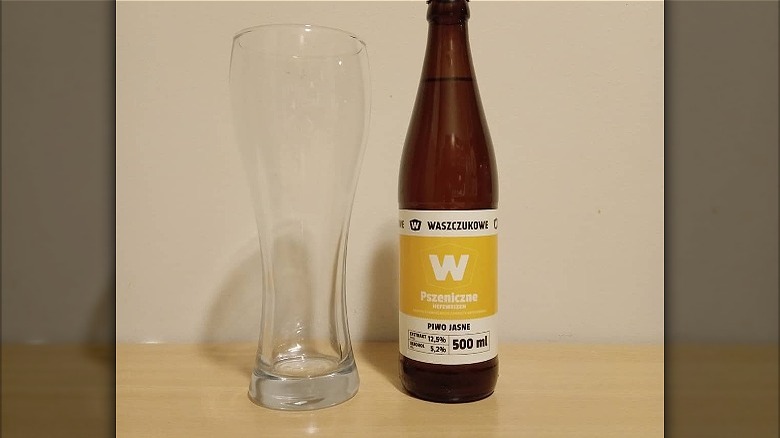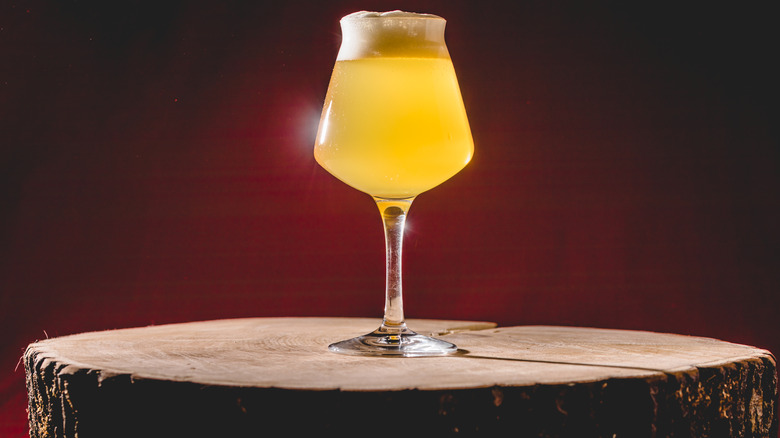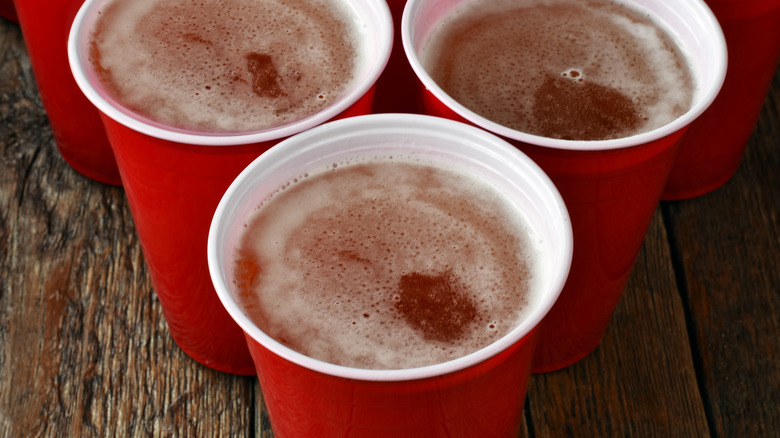15 Types Of Glasses To Complement Your Beer
Choosing the right type of glassware can be as crucial as choosing the right beer. Nobody wants to drink a $13 craft beer out of a Disneyland coffee mug, and no one wants to drink Milwaukee's Best out of a crystal snifter. To achieve the optimal beer drinking experience, complementing the right beer glass to your choice of beer is crucial.
Matt Rutkowski, vice president of Spiegelau USA, explained to The Washington Post that the idea of "flavor-enhancing beer glasses" was similar to "making sure you have a good racket whenever you're playing tennis." Rutkowski elaborated that while "there's kind of a tradition of associating a glass with a certain beer brand" — like the Stella Artois chalice-style beer glass — people don't necessarily associate the relationship between beer styles and certain kinds of glassware.
Vinepair compared the phenomenon to how different styles of wine glasses draw out or enhance notes in certain wines. Pairing the glass with the beer not only impacts the aroma and foamy head of certain beers, but it can open the palette to all the possible flavor nuances. A good rule of thumb is that fizzier beers pair best in a thinner glass to create a smaller head, while less fizzy beers, like stouts, can be put in wider glasses (via Gizmodo). Whether you partake in sours, IPAs, stouts, wheat beers, or anything in between, there is a perfect beer glass out there to make you look and feel like a beer connoisseur.
Snifter glass
Most people are familiar with the snifter glass, thanks to its iconic shape and short stature. It is usually characterized by its short stem and round or balloon-shaped bowl that tapers tightly at the top (per Which Beer Glass). Originally designed for sipping cognac or whiskey, snifter glasses are suited for a wide range of beer, specifically aromatic brews and strong ales (via Mr. Beer).
What gives snifters the advantage is not only their swirling capability but also their ability to concentrate aromas at the top of the narrow rim that allows you to pick up on more subtle or complex notes. In most cases, drinking warm beer is not preferred; however, the glass' shape helps naturally transfer heat from your hand to the beer, which allows it to open up more. Given that, chocolate, coffee, bourbon stouts, and porters with a high ABV really benefit from a swish and a swirl in a snifter (per Which Beer Glass). However, rich and potent Belgian ales like Belgian triples, quads, or some heavier IPAs are evened out with the help of a snifter (via Mr. Beer).
Tulip glass
Similar to a thistle glass, tulip glasses have a bowl shape slightly similar to snifters, but with an edge that flares out as opposed to tapering in at the mouth. There are a few different varieties of tulip beer glasses, such as the stemless English tulip pint glass or the chalice tulip glass, which is most famously recognized as the Stella Artois beer glass (via Which Beer Glass).
The Los Angeles Times claimed that the tulip beer glass is the only craft beer glass you need behind your home bar. Holding between 16 and 20 ounces, it's one of the more versatile beer glasses, and it enhances the hoppiest of IPAs, double IPAs, and even the darkest of porters. The tapered rim works well with beers that have foamier heads or heavy hops flavors in order to best draw out the smells from the head (via Vinepair). Also known as the "Belgian ale glass," it also balances well with many varieties of Belgian ales, barrel-aged beers, floral and hoppy wild ales or farmhouse ales, and even malty Scotch ales (via Which Beer Glass).
Pint glass
There are many different types of pint beer glasses used around the world that cater to different beer styles. One of the most recognizable pint glasses, the U.S. shaker pint or the conical pint glass, was never meant to be a beer drinking glass (via Indiana On Tap). After WWI, and during Prohibition times, many craft breweries went out of business, leaving larger companies like Coors and Schlitz to serve mass quantities of slightly alcoholic water (via Bloomberg).
Most restaurants had shaker glasses for cocktail making and figured that the cheap, durable, and stack-able glassware everyone had would suffice given the lack of beer options at the time (via Bloomberg). Honestly, we can't say that any beer is made better in a shaker pint glass unless it's a draft Pabst Blue Ribbon or maybe a lukewarm can of Bud Light.
That being said, the nonic pint glass, or the British imperial pint, is utilitarian like the shaker pint but with a slightly better design and a signature bulge near the rim of the glass (via Lowercase Brewing). It was initially designed in the early 1900s as a glass alternative that didn't easily nick on the lip when stacked on tops of other glasses, hence the name "no-nick" (per Indiana On Tap). Since the glass is mostly for utility purposes, it's not suited for any beer in particular, but works with low ABV beer that can be consumed in large amounts (via Which Beer Glass).
Dimple mug
The dimple mug is a classic beer drinking receptacle that is not only nostalgic, but also says "I love drinking large amounts of wheat beer." An icon in English pub culture, the glass was originally invented in 1938 in Lancashire, England, and despite its heavy weight and thickness, it blew up across England (via Zythophile). The bottom of the mug reflects light through a beer like a kaleidoscope.
It is also very similar to the Tübinger Kugel beer mug, originating from the 1800s and mainly used in Germany and Czechia. Its dimpled texture was said to be modeled after the skin of a hedgehog (via Casket Beer). In 2001, the dimpled mug almost disappeared entirely from production before making a resurgence in the U.K. and U.S. in the 2010s. The BBC regaled how it was nice to see a piece of British history make its way back into modern times, even if some find it clunky and unattractive. Not only is it a massive glass made heavier by thick walls of glass, but it doesn't enhance a beer's aromas with its wider rim. Regardless, it's still a piece of nostalgic glassware that, like a pint glass, is perfect for low ABV but insanely chuggable brews.
Stange glass
No, this is not a misspelling of "strange" glass, even though there is nothing strange or unusual about this glass. Originating from Germany, stange glasses are commonly seen in western parts of Germany, specifically Cologne. Traditionally only 6 ounces for fast consumption, stange glasses are shaped perfectly like a cylinder and are small enough to be carried on a kranz tray by the dozen (per Beers with Mandy).
A stange glass now closely resembles a 12-ounce highball glass, with a narrow and non-tapered rim. It's usually slightly taller and narrower than a shaker pint, with a thick base that is also lightweight and sturdy (via Dimensions). Stange glasses benefit beers with lower carbonation since the tall and narrow build helps with head retention. Traditionally, stange glasses are usually used to serve kölsch beers, but also to enhance light Pilsners, gose beers, Belgian Lambics, and rauchbier (via Which Beer Glass).
Yard glass
Drinking a yard of beer can seem like a daunting rite of passage into adulthood, but with the right technique, anyone can conquer the "yardie." The origins of the yard glass are not the most conclusive, but most can agree that it first made an appearance in 17th century England. Originally known as the "ell glass," it was named for the English ell measurement for one yard (via Faithful Readers).
Many researchers believe that the yard glass was used to toast King James II, but that it also had plebeian origins as a drinking glass for stagecoach drivers in need of a quick chug and run. There is also evidence that the yard glass was used as part of a drinking ceremony at Eton College in the 1800s (where it was called "the long glass"), but it's hard to pin down an exact origin (via Zythophile).
Today, yard glasses are popular in New Zealand, Australia, and the U.K., and are the center of a 21st birthday drinking tradition called a "yardie" (via Stuff). Yard glasses are not commonly used in the U.S. unless you partake at the nationwide chain Yard House, which serves dozens of draft beers in the gargantuan glass. The average yard glass is around 3 feet tall, as tall as a baseball bat (via Dimensions), and holds around 2.7 liters (via Stuff). Like with most chugging beer glasses, a lighter and more neutral beer with less carbonation would be best suited for this tall glass.
Pilsner glass
Shockingly, Pilsner glasses go surprisingly well with Pilsner-style beers. The Pilsner glass is pretty recognizable at first glance with its towering height that surpasses the shaker pint and Das Boot beer glass. It has a wider base, and signature V-shaped design (via Dimensions). Modern-day Pilsner glasses date back to the 16th century "Passglas," which look like a mixture between a champagne flute and a Stange glass. The actual Pilsner glass was invented sometime after 1842 by the Pilsner Urquell brewery in response to needing a glass for their newly-invented Pilsner beer (via Casket Beer).
Pilsner glasses are meant to showcase the beer's carbonation and champagne-like head, making it a great option for maintaining head retention. However, Pilsners are not the only beers that benefit from being served in a Pilsner glass. Beers like American and Japanese lagers, bocks, helles bocks, maibocks, and blond ales will further enhance a light-bodied beer's aromatic and flavorful foamy head (per Home Brew Academy).
Das Boot beer glass
More correctly known as a "bierstiefel," the beer boot is perhaps one of the most iconic and recognizable beer drinking glasses for its unmistakable appearance. In 2006, when the beer Olympics film "Beerfest" premiered, the movie led to a surge in the bierstiefel's popularity and use of the nickname "Das Boot" (per Webstaurant Store). The beer boot's origin is inconclusive at best; instead, we've found a lot of urban legends.
Many sources believe that the first glass was created after a Prussian general agreed to make a beer glass modeled after his boot if his troops scored a win on the battlefield. Other sources believe that it was inspired by some Medieval hazing ritual where people drank beer from their boots (via KegWorks). There are also roots of the boot glass in English riding and hunting clubs in the early 1800s before it became trendy in Germany (via Webstaurant Store).
Beer boots tend to differ in size and design, but most are around 2 liters, which is the equivalent of six 12-ounce beers (via KegWorks). There is an art to drinking a bierstiefel, starting with drinking the boot with the toe pointing up and slowly rotating the boot 90 degrees until the beer reaches the ankle of the boot (via Webstaurant Store). Since this is a beer glass meant for quick consumption, lighter beers will be best in a beer boot, especially crispy beers like hefeweizens, Pilsners, doppelbocks, altbiers, and other German or Bavarian beers.
Goblet glass
Also known as a chalice, the goblet glass has a wider bowl similar to a snifter but with a less tapered rim and a taller stem, similar to a wine glass. Most people think of Medieval times and "Monty Python and the Holy Grail" when thinking about goblets, which isn't far off from the origin. These glasses were used during Medieval times for drinking stronger beers and wine, and have religious origins as well. They have become associated with Belgian-style beers due to breweries using goblet glasses as their branded glassware (via Hand Family Companies).
Goblets tend to come in a variety of sizes that can usually hold more than a typical pint glass. The goblet's wider mouth best enhances heavier and maltier beers that are best enjoyed in larger sips. It also helps with head retention with thicker, stout-like beers (per Mr. Beer). Goblets tend to be made of thick glass to help keep malty beers between a slightly warmer 50 to 60 degrees Fahrenheit (via Hand Family Companies).
Despite the emphasis on enhancing thick malty beers, vibrant and slightly floral beers like Belgian ales, wild ales, saisons, farmhouse ales, barleywines, wheat wines, and even some ciders are best enjoyed in a goblet glass (via Hand Family Companies). Certain IPAs from Belgian and dubbels also work well when enjoyed in a chalice or goblet glass (via Mr. Beer).
IPA glass
For a robust and complex beer like an IPA, it's important to showcase the brew's complexities in a uniquely tailored glass. While it may not be necessary to fully enjoy a good IPA, putting said beer in an IPA glass will not only enhance all the nuanced aromas, but it will make you look like a professional hipster.
IPAs, or Indian pale ales, first originated in London in the 1700s, created to be strong and semi-shelf stable beers to transport from England to India. They slowly fell out of style until the 1970s when U.S. brewers started reinventing the British specialty beer with its signature hops flavor (via Craft Beer Glasses). Today, there are about a dozen different styles of IPAs, from earthy English IPAs and citrusy West Coast IPAs to DIPAs, triple IPAs, and even black IPAs (via Webstaurant Store).
However, IPA-specific glasses didn't become mainstream until glass company Spiegelau released craft beer-specific glasses and the design became streamlined. IPA glasses are designed to preserve IPA's or other pale ale's carbonation and head, which holds a lot of the beer's flavor. The narrow rigid base keeps the beer fresh and carbonated longer and the bulbous upper body allows the hops' aromas and flavors to concentrate at the head (via Craft Beer Glasses). Some IPA glasses are even nucleated, meaning that they have a ring at the bottom of each glass for carbonation to form (via Webstaurant Store).
Stout glass
Just like with other specialty glasses, stouts don't have to be served in a snifter glass. Stouts, compared to most light beers, are usually dark and borderline savory that can have notes of maltiness, nuttiness, chocolate, coffee, oatmeal, or other rich flavors. They were made popular in Great Britain and Ireland, home of the eternally famous Guinness, in the 18th century. At that time, stout was just another word used to describe any dark beer, or porter, that had an ABV over 7% (per Britannica).
Slightly similar in complexion to the Spiegelau IPA glass, its stout glass version has a narrow base without ridges, a slightly shorter frame, and a curved upper body with a flatter base. Gizmodo reported in 2014 that it was considered the world's first-stout specific beer glass, released in collaboration with Left Hand Brewing, Rogue Ales, and Spiegelau. Compared to its IPA glass counterpart, "it's like comparing a Ferrari and a Lamborghini," according to Brett Joyce at Rogue — both work well and the beer goes down fast, thanks to the superior taste-enhancing design.
Wired reported in a taste test that drinking a stout in the specialty stout glass as opposed to a pint glass enhanced the beer's smell and taste while maintaining its creamy consistency and head retention. Even if you aren't a fan of stouts, porters, some very dark lagers, and Scottish ales can only be made better in a stout-specific beer glass.
Willi Becher glass
The Willi Becher, or the willybecher, glass is considered the go-to German-style pint glass. Similar to a Pilsner glass, it has a reversed hourglass shape that starts narrow, curves out, and tapers inward toward the rim (per Which Beer Glass). It was originally designed in 1954 in Germany and named the Willi Becher (which translates to "Willy cup") after the inventor, Willy Steinmeier. Like most pint glasses, it's used more for utilitarian purposes than drinking purposes but has a better design that complements German-style beers (via Casket Beer).
Willi Becher glasses often have the functionality and versatility of tulip glasses, where the narrow body helps control fizzier beers and the tapered top helps to retain its aromatic head. Though typically 20 ounces, Willi Becher glasses can range in sizes from 5 to 17 ounces. Of course, this German pub glass would go best with low ABV German lagers and ales, especially märzens and rauchbiers (via Which Beer Glass). However, other lighter beers like Pilsners, kölsch, or altbiers would pair well in this practical beer glass.
Weizen glass
Also known as a wheat beer glass, the weizen glass is almost vase-like in appearance that closely resembles a Pilsner glass. That being said, weizen glasses are more curved at the top than contrasting Pilsner glasses and are commonly recognized by their narrow bases and slightly tapered lips (via Dimensions).
Traditionally, German hefeweizen, originating from Bavaria, is served in a weizen glass. The literal translation of hefeweizen means "yeast wheat," and traditional styles of this beer require that the beer be made with at least 50% wheat. Hefeweizens are typically a darker brown color than other German beers, cloudier in complexion, and commonly have notes of banana, clove, and other spices (via Brew-ed).
Weizen glasses are especially beneficial at maintaining good head retention for light and highly carbonated wheat beers, enhancing those minute fruit flavors. The tall height and tapered bottoms of each glass also help to keep sediment and yeast from floating to the top of the glass when you're sipping. While hefeweizens are the preferred beer for this glass, other weizen varieties like dunkelweizen, kristalweizen, and weizenbock pair well. If you want to mix it up, other wheat or high-carbonation beers like American wheat ales — and sour wheat beers like goses — are great alternatives to drink in a weizen glass (per Mr. Beer).
Teku glass
Now, we have talked extensively about specialty glasses and how you need them all to elevate your drinking experiences. That being said, the Rastal Teku glass is the only craft beer glass you need behind your home bar. Originally designed by craft beer extraordinaires Teo Musso and Lorenzo "Kuaska" Dabove, the perfectly curved Teku glass is marketed as the glass meant for tasting, not just drinking. The tulip-style glass almost resembles a stemmed red wine glass with a chimney-shaped upper bowl area for ultimate aroma concentration.
Teku glasses are also one of the most versatile beer glasses on the market, complementing everything from sours and IPAs to wheat beer, stouts, ciders, and everything in between. Wirecutter wrote a rave review of the practical yet uniquely elegant beer glass, explaining how it was a "one-size-fits-all model for beer glassware." Its lightly flared rim enhances even the most secondary of tasting notes, crafting the perfect foamy head on every beer, and its long stem prevents beers from being over-warmed as they're held. In essence, it's "the beer equivalent of a wine glass" and it would be a challenge to find a beer that wasn't improved thanks to the Teku.
Red Solo cup
It's hard not to associate a red SOLO cup with a long-standing tradition of underage binge drinking. Plus, for anyone who hasn't heard Toby Keith's ode to the "Red Solo Cup," it has a way of connecting people by giving them enough alcohol to sedate a large horse while swaying and singing country music in unison.
The red SOLO cup wasn't originally supposed to be the world's favorite party glass. It was originally invented in 1936 by Leo Hulsemen as a paper cone that was both disposable and sanitary. It wasn't until the 1970s that the red SOLO cup we know and momentarily cherish was available to the masses. Known for its iconic lines and ridges, many people believed that the lines were designed to be makeshift markers to measure out 1 ounce of liquor, 5 ounces of wine, and 12 ounces of beer (via Facebook).
While surprisingly accurate, the theory didn't live up to the truth. The lines were intended to have more of a practical and natural purpose –– the curved rim prevents cups from sticking together, the indented base prevents each cup from cracking, and the lines in the middle of the cup keep it from slipping out of your hand (via Politifact). There aren't many fruity sours or hoppy IPA craft beers we think would be enhanced in a red SOLO cup. However, beers poured directly from a keg and foamy beyond all recognition are the preferred beers to complement this ever-lasting beer glass.
